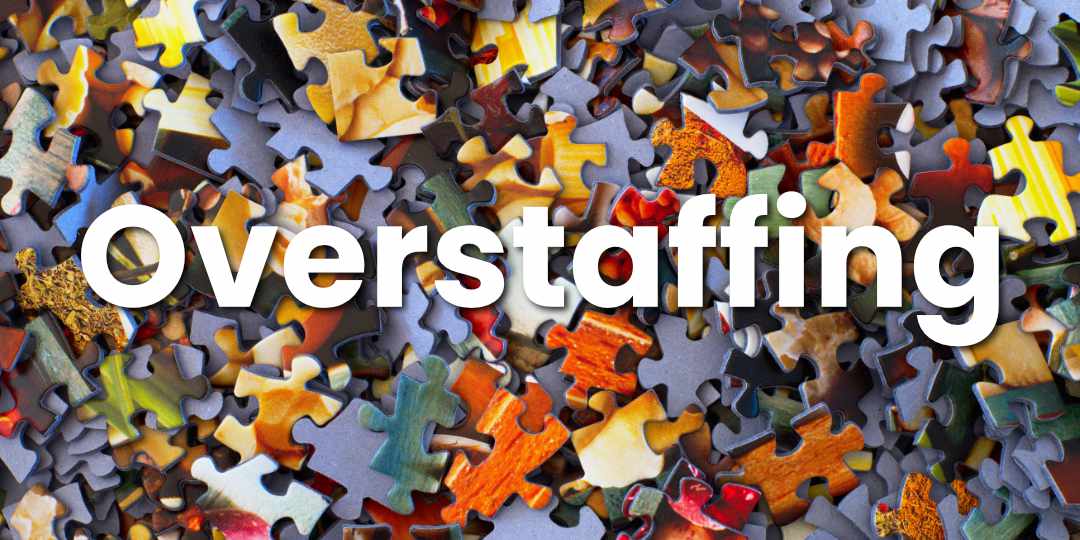Overstaffing Problems: Common Issues and How to Avoid Them
If you find yourself overstaffed, it’s probably because at some point in the year, you will need the number of workers that you have. You don’t want to get caught understaffed when a big project comes up, so you take what seems like the lesser of two evils and hire more people than you really need throughout the rest of the year.
However, you might start to realize there’s a problem when workers start walking up to you asking for work to do. How could this be? Isn’t there always work to be done? If you’re hearing that your workers are out of things to do, you might be seeing one of the effects of overstaffing.
At Veryable, we see this happen all the time. We work with companies to connect them with on-demand labor, which can enable businesses to escape overstaffing. Naturally, we are biased towards on-demand labor, but the problems with overstaffing are the same whether you choose to try our solution or not. We want to share what we have seen and what we have found to work when addressing overstaffing.
By the end of this article, you will know the costs and operational headaches that come with overstaffing and how you can avoid and escape these common problems by addressing the root cause.
Contents:
- Common problems caused by overstaffing
- How to stop overstaffing your business
- Making the transition away from overstaffing
Common problems caused by overstaffing
The problems with overstaffing are probably all too familiar to you. When you are overstaffed, the most readily apparent problem is that you’re paying people with little or no work to do. This inefficiency is only the start of the problems, however. Because employees are people, and people like consistency and hate wasting time, your people are less likely to be happy.
In previous articles, we’ve talked about the financial cost of overstaffing your business, and in this article, we’d like to highlight something not discussed too often: the frustrations and second order effects that come with overstaffing your business.
The complications and frustrations usually happen in three stages:
- Offering unwanted time off
- Looking for any type of work to keep employees busy
- Reducing employee hours and morale
Let’s briefly break down these three stages to fully understand the hidden costs of overstaffing in your business.
Stage 1: Offering unwanted time off
The day starts out and you know you have enough demand for 40 people but you have 50 people scheduled. You let your operations team know that they can let people have the day off if they want. They hit the floor asking, but only 3 people want to go home, the rest would like their full 40 hours for the week, deservedly so. You’ll now have to manage the day with 7 people more than you need, you know your efficiency metrics are going to take a hit.
Stage 2: Looking for work to give
Since there are too many people in the building, the work that you did have begins to dry up. You get people coming up to you asking what they should do as they’re trying to stay productive. You scramble to try and find activities for them to do like clean up or organize the building, but you know you don’t have any value-add work to do. You can feel your cost per unit steadily increasing and there’s nothing you can do about it.
Stage 3: Reducing hours and morale
The week is over and you’re now planning for next week. You’re evaluating your operations metrics and you’re seeing how bad they look, leaving you with no choice but to cut hours next week. You end up scheduling each full-time employee for only 32 hours instead of 40.
You now have to communicate to everyone their schedule for next week. It feels terrible, and there’s no one out there that ever wants to be in this situation. When word gets out, certainly some people aren’t happy.
Employees feel money has been taken out of their pocket, the morale of the team sinks, and it becomes hard to motivate anybody. This erosion of trust will come back to haunt you when volume spikes and you aren’t able to satisfy your customers because your employees won’t give 100% of their effort. Why would anybody want to work harder to finish the demand knowing that means they could just be sent home?
How to stop overstaffing your business
So you find yourself stuck with the frustrations of overstaffing, but you don’t want to feel like the bad guy and fire a bunch of your employees. Let’s go over what you can do now to get back to your optimal headcount.
Step 1: Stop planning headcount based only on averages
To know how low you can afford to let your headcount get, figure out what your full-time headcount needs to be to support your minimum demand. You don’t need to start firing people the moment you find this number; this count is good to know so that as natural turnover occurs, you will understand how long you can go without replacing the employees that leave.
Step 2: Stop backfilling your attrition
Your workforce probably looks something like the image below, which illustrates a common turnover rate and common reasons workers leave.

Now that you know headcount needed, as attrition happens, simply don’t backfill those positions if you’re still above your minimum headcount.
As discussed in our blog on why you should stop planning headcount by averages, if demand requires more than your minimum headcount, you can then combine your full-time headcount with part-time, temporary, or on-demand workers to achieve more flexibility in your operations. This is how you avoid never being understaffed or overstaffed.
Additionally, after your top 10% and bottom 10% leave your company, the 80% who remain can feel more secure because they aren’t seeing turnover as often. This also allows you to take the money you were using to backfill your attrition and invest it in your 80% throughout the slower parts of the year by giving them training and incentives to boost performance. A true win-win!
Step 3: Find an agile source for workers when needed
When your full-time headcount can’t manage your current demand, utilize on-demand staffing, temp agencies, or on-demand labor platforms like Veryable to help get workers into your building quickly.
This will allow you to respond to demand as it comes, instead of trying to massage it to fit your full-time headcount. Preparing for demand changes by adopting a more flexible model will empower you to avoid overstaffing and reap the rewards of lower costs and less stress for you.
Making the transition away from overstaffing
If you make changes to use a more flexible model, then you can avoid many of the costs and frustrations that come with overstaffing. By only paying the full-time staff that you absolutely need and bringing in workers as the need arises, you can save money and remove the hassles that come with overstaffing.
It will be much easier to find additional workers for short periods of time than it would be to continue doing the dance of offering time off, finding busy work, and reducing employee hours. This transition can be difficult, but one that is worth the effort.
To learn how Veryable can help you eliminate overstaffing for good, click here.
Previous Posts
Why Veryable Was Created: The Origin, the Industry Problems Behind It, and How Real-World Experience Shapes Our Mission Today
The Future of Manufacturing and Logistics
Create a free business profile today to explore our platform.






